MLC101
VerifiedAdded on 2022/11/22
|7
|1604
|88
AI Summary
The document provides case law analysis for MLC101 course covering three scenarios related to contract of employment, insurance policy and human rights abuse. The document explains the issues, rules and applications of the rules in each scenario and concludes with references.
Contribute Materials
Your contribution can guide someone’s learning journey. Share your
documents today.
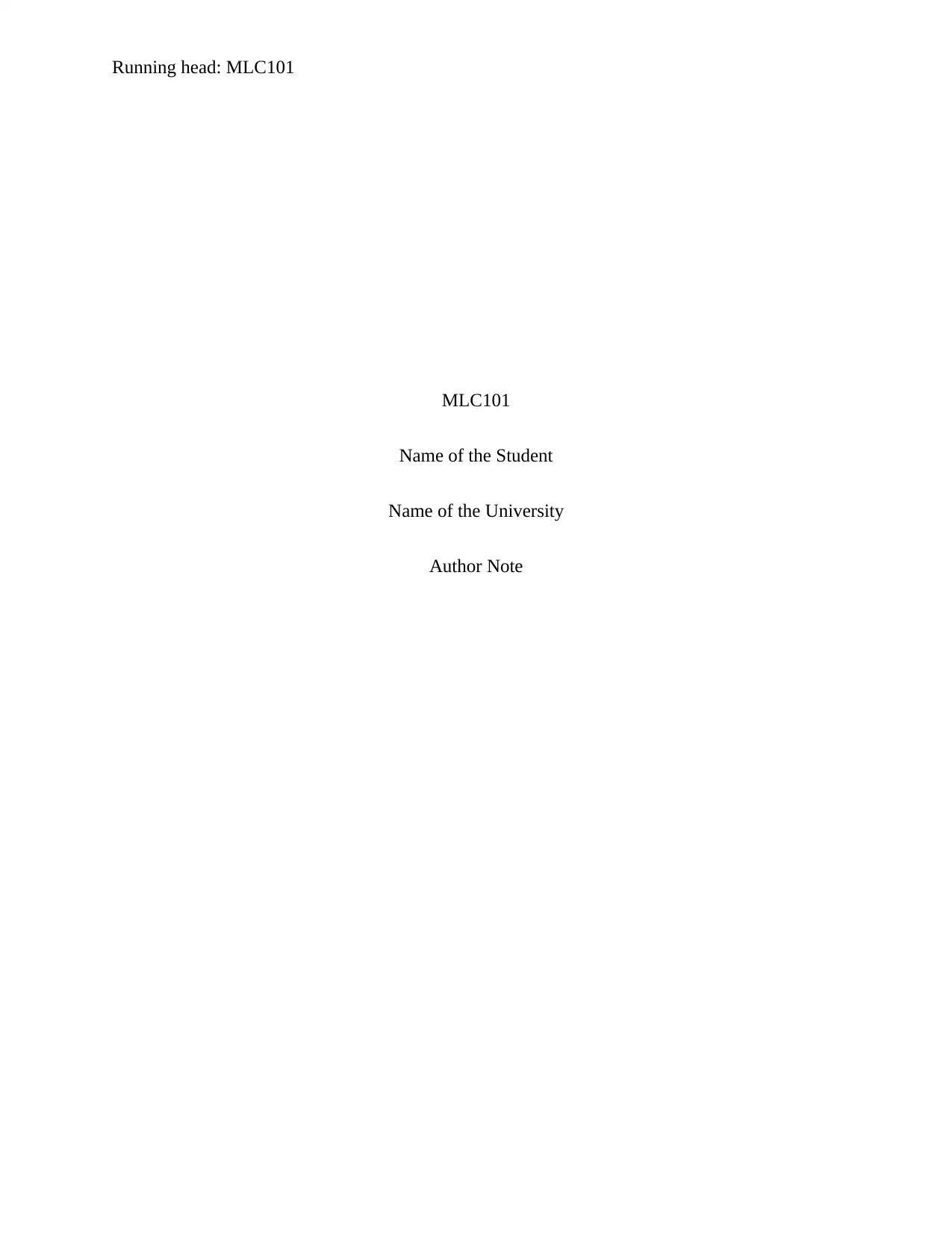
Running head: MLC101
MLC101
Name of the Student
Name of the University
Author Note
MLC101
Name of the Student
Name of the University
Author Note
Secure Best Marks with AI Grader
Need help grading? Try our AI Grader for instant feedback on your assignments.
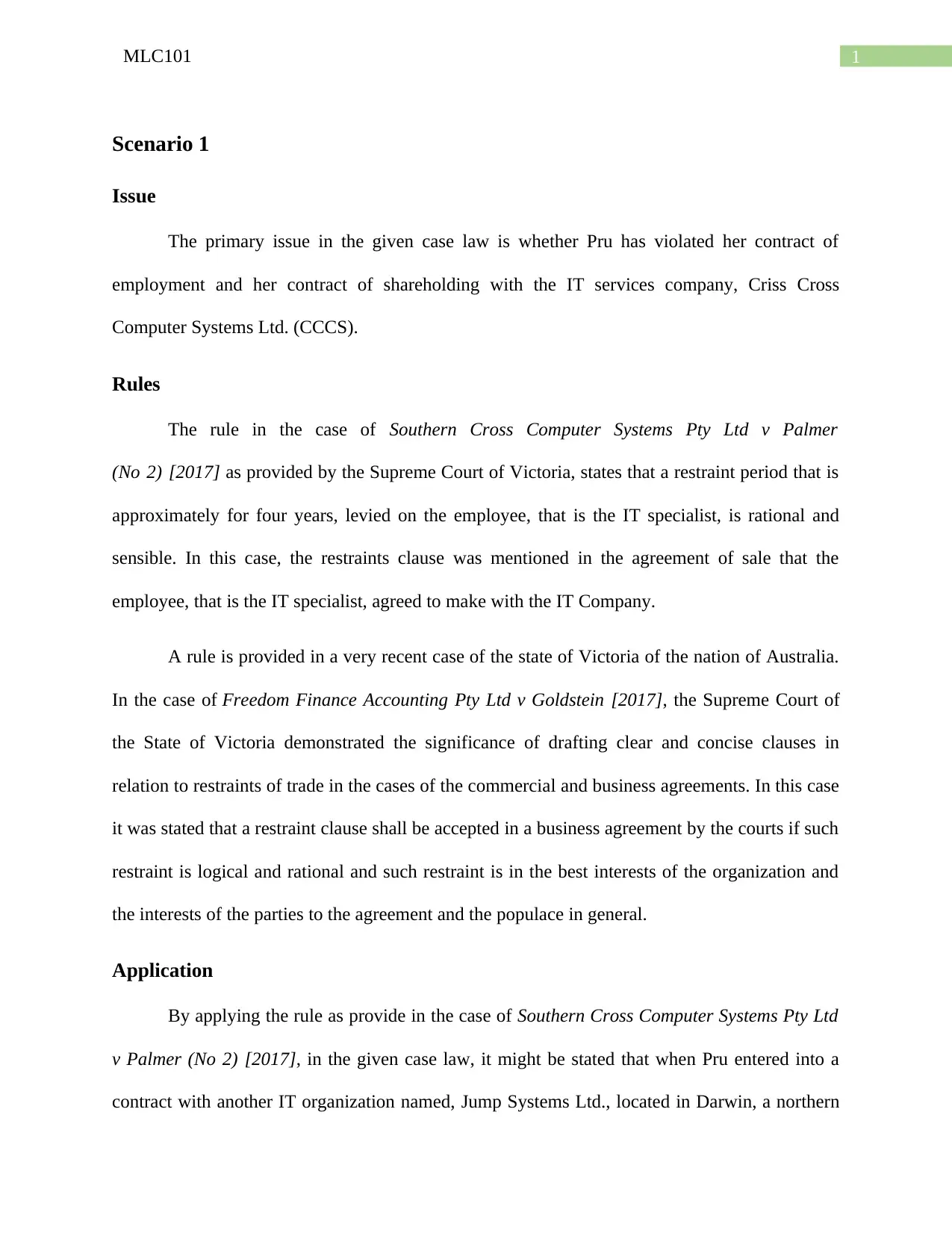
1MLC101
Scenario 1
Issue
The primary issue in the given case law is whether Pru has violated her contract of
employment and her contract of shareholding with the IT services company, Criss Cross
Computer Systems Ltd. (CCCS).
Rules
The rule in the case of Southern Cross Computer Systems Pty Ltd v Palmer
(No 2) [2017] as provided by the Supreme Court of Victoria, states that a restraint period that is
approximately for four years, levied on the employee, that is the IT specialist, is rational and
sensible. In this case, the restraints clause was mentioned in the agreement of sale that the
employee, that is the IT specialist, agreed to make with the IT Company.
A rule is provided in a very recent case of the state of Victoria of the nation of Australia.
In the case of Freedom Finance Accounting Pty Ltd v Goldstein [2017], the Supreme Court of
the State of Victoria demonstrated the significance of drafting clear and concise clauses in
relation to restraints of trade in the cases of the commercial and business agreements. In this case
it was stated that a restraint clause shall be accepted in a business agreement by the courts if such
restraint is logical and rational and such restraint is in the best interests of the organization and
the interests of the parties to the agreement and the populace in general.
Application
By applying the rule as provide in the case of Southern Cross Computer Systems Pty Ltd
v Palmer (No 2) [2017], in the given case law, it might be stated that when Pru entered into a
contract with another IT organization named, Jump Systems Ltd., located in Darwin, a northern
Scenario 1
Issue
The primary issue in the given case law is whether Pru has violated her contract of
employment and her contract of shareholding with the IT services company, Criss Cross
Computer Systems Ltd. (CCCS).
Rules
The rule in the case of Southern Cross Computer Systems Pty Ltd v Palmer
(No 2) [2017] as provided by the Supreme Court of Victoria, states that a restraint period that is
approximately for four years, levied on the employee, that is the IT specialist, is rational and
sensible. In this case, the restraints clause was mentioned in the agreement of sale that the
employee, that is the IT specialist, agreed to make with the IT Company.
A rule is provided in a very recent case of the state of Victoria of the nation of Australia.
In the case of Freedom Finance Accounting Pty Ltd v Goldstein [2017], the Supreme Court of
the State of Victoria demonstrated the significance of drafting clear and concise clauses in
relation to restraints of trade in the cases of the commercial and business agreements. In this case
it was stated that a restraint clause shall be accepted in a business agreement by the courts if such
restraint is logical and rational and such restraint is in the best interests of the organization and
the interests of the parties to the agreement and the populace in general.
Application
By applying the rule as provide in the case of Southern Cross Computer Systems Pty Ltd
v Palmer (No 2) [2017], in the given case law, it might be stated that when Pru entered into a
contract with another IT organization named, Jump Systems Ltd., located in Darwin, a northern
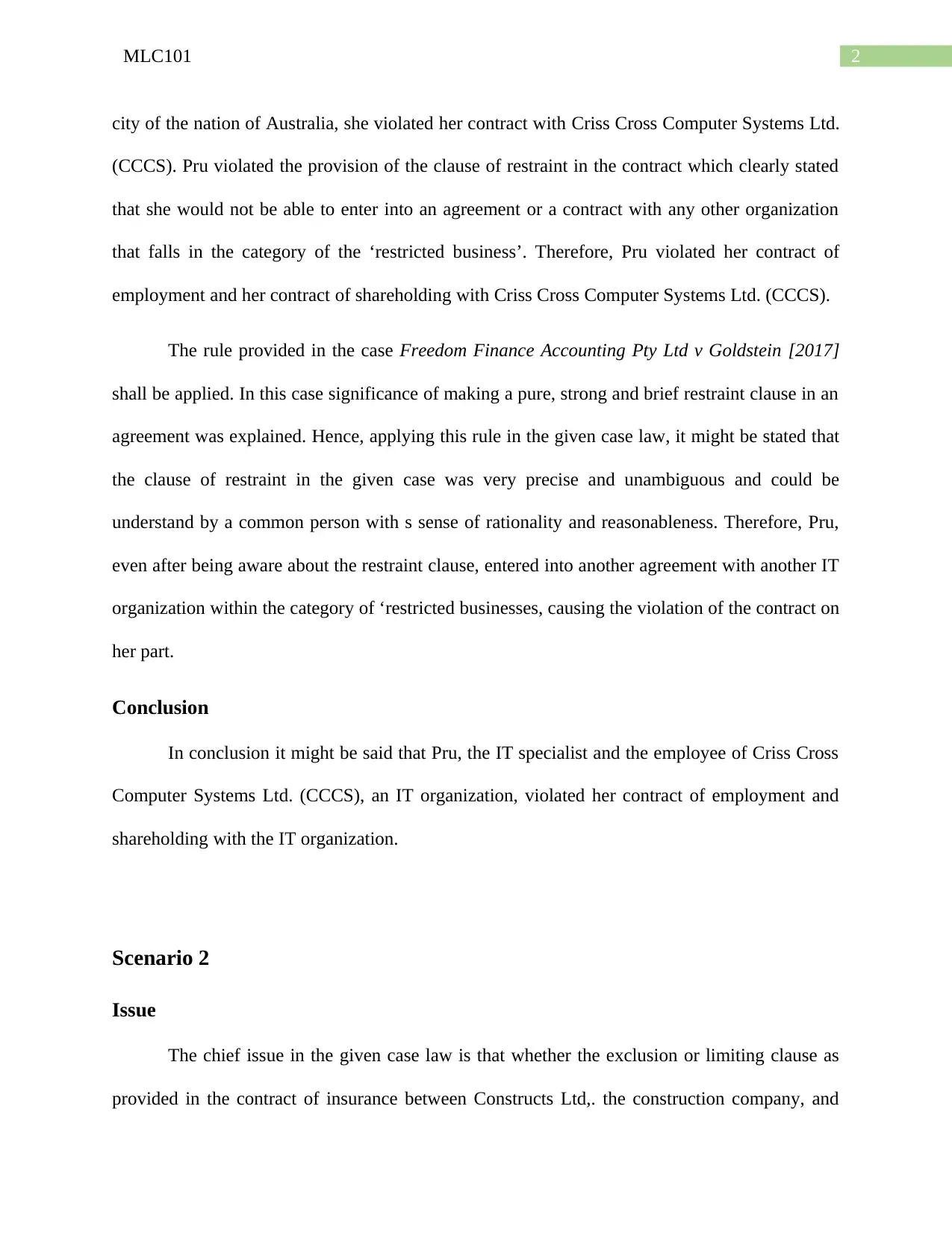
2MLC101
city of the nation of Australia, she violated her contract with Criss Cross Computer Systems Ltd.
(CCCS). Pru violated the provision of the clause of restraint in the contract which clearly stated
that she would not be able to enter into an agreement or a contract with any other organization
that falls in the category of the ‘restricted business’. Therefore, Pru violated her contract of
employment and her contract of shareholding with Criss Cross Computer Systems Ltd. (CCCS).
The rule provided in the case Freedom Finance Accounting Pty Ltd v Goldstein [2017]
shall be applied. In this case significance of making a pure, strong and brief restraint clause in an
agreement was explained. Hence, applying this rule in the given case law, it might be stated that
the clause of restraint in the given case was very precise and unambiguous and could be
understand by a common person with s sense of rationality and reasonableness. Therefore, Pru,
even after being aware about the restraint clause, entered into another agreement with another IT
organization within the category of ‘restricted businesses, causing the violation of the contract on
her part.
Conclusion
In conclusion it might be said that Pru, the IT specialist and the employee of Criss Cross
Computer Systems Ltd. (CCCS), an IT organization, violated her contract of employment and
shareholding with the IT organization.
Scenario 2
Issue
The chief issue in the given case law is that whether the exclusion or limiting clause as
provided in the contract of insurance between Constructs Ltd,. the construction company, and
city of the nation of Australia, she violated her contract with Criss Cross Computer Systems Ltd.
(CCCS). Pru violated the provision of the clause of restraint in the contract which clearly stated
that she would not be able to enter into an agreement or a contract with any other organization
that falls in the category of the ‘restricted business’. Therefore, Pru violated her contract of
employment and her contract of shareholding with Criss Cross Computer Systems Ltd. (CCCS).
The rule provided in the case Freedom Finance Accounting Pty Ltd v Goldstein [2017]
shall be applied. In this case significance of making a pure, strong and brief restraint clause in an
agreement was explained. Hence, applying this rule in the given case law, it might be stated that
the clause of restraint in the given case was very precise and unambiguous and could be
understand by a common person with s sense of rationality and reasonableness. Therefore, Pru,
even after being aware about the restraint clause, entered into another agreement with another IT
organization within the category of ‘restricted businesses, causing the violation of the contract on
her part.
Conclusion
In conclusion it might be said that Pru, the IT specialist and the employee of Criss Cross
Computer Systems Ltd. (CCCS), an IT organization, violated her contract of employment and
shareholding with the IT organization.
Scenario 2
Issue
The chief issue in the given case law is that whether the exclusion or limiting clause as
provided in the contract of insurance between Constructs Ltd,. the construction company, and
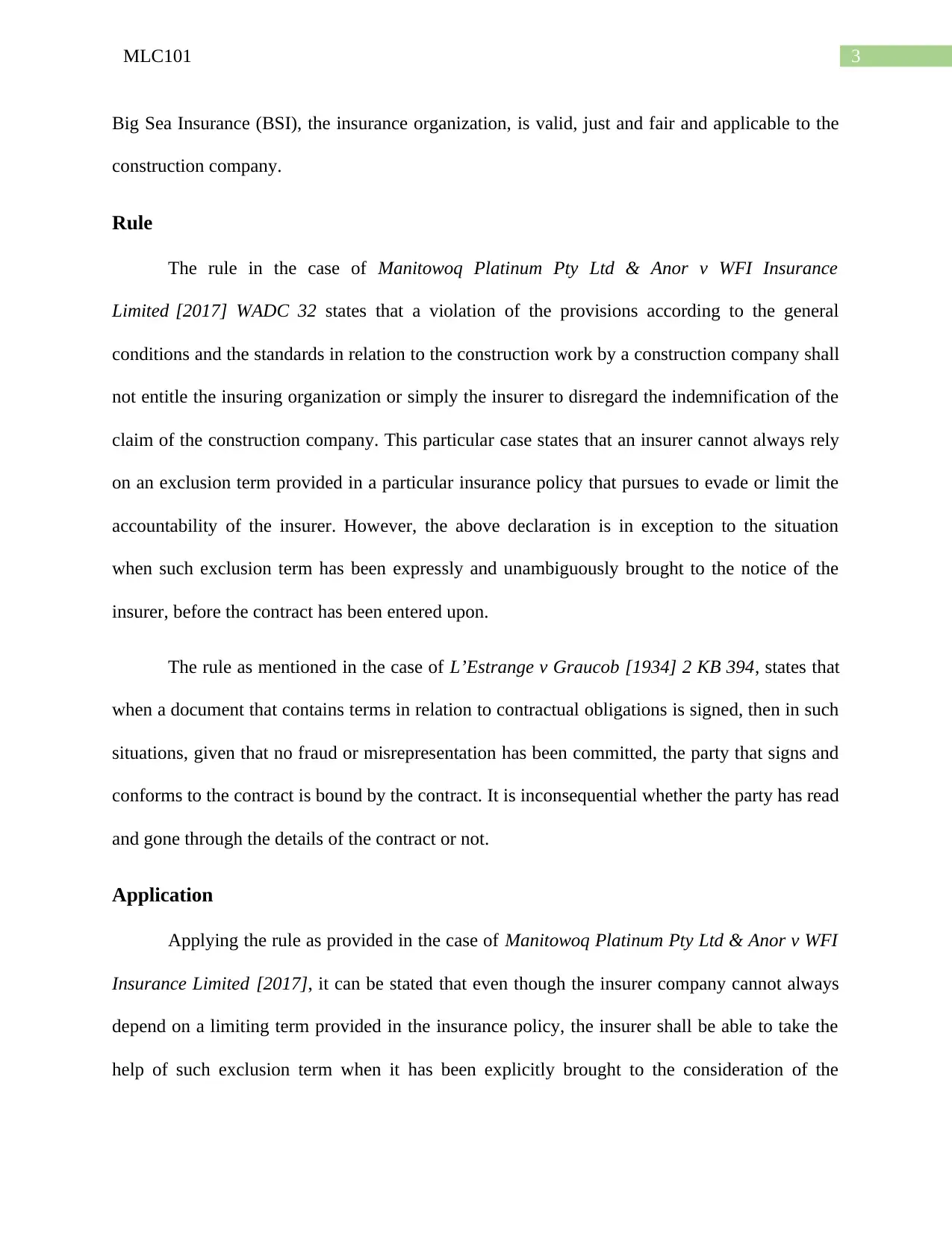
3MLC101
Big Sea Insurance (BSI), the insurance organization, is valid, just and fair and applicable to the
construction company.
Rule
The rule in the case of Manitowoq Platinum Pty Ltd & Anor v WFI Insurance
Limited [2017] WADC 32 states that a violation of the provisions according to the general
conditions and the standards in relation to the construction work by a construction company shall
not entitle the insuring organization or simply the insurer to disregard the indemnification of the
claim of the construction company. This particular case states that an insurer cannot always rely
on an exclusion term provided in a particular insurance policy that pursues to evade or limit the
accountability of the insurer. However, the above declaration is in exception to the situation
when such exclusion term has been expressly and unambiguously brought to the notice of the
insurer, before the contract has been entered upon.
The rule as mentioned in the case of L’Estrange v Graucob [1934] 2 KB 394, states that
when a document that contains terms in relation to contractual obligations is signed, then in such
situations, given that no fraud or misrepresentation has been committed, the party that signs and
conforms to the contract is bound by the contract. It is inconsequential whether the party has read
and gone through the details of the contract or not.
Application
Applying the rule as provided in the case of Manitowoq Platinum Pty Ltd & Anor v WFI
Insurance Limited [2017], it can be stated that even though the insurer company cannot always
depend on a limiting term provided in the insurance policy, the insurer shall be able to take the
help of such exclusion term when it has been explicitly brought to the consideration of the
Big Sea Insurance (BSI), the insurance organization, is valid, just and fair and applicable to the
construction company.
Rule
The rule in the case of Manitowoq Platinum Pty Ltd & Anor v WFI Insurance
Limited [2017] WADC 32 states that a violation of the provisions according to the general
conditions and the standards in relation to the construction work by a construction company shall
not entitle the insuring organization or simply the insurer to disregard the indemnification of the
claim of the construction company. This particular case states that an insurer cannot always rely
on an exclusion term provided in a particular insurance policy that pursues to evade or limit the
accountability of the insurer. However, the above declaration is in exception to the situation
when such exclusion term has been expressly and unambiguously brought to the notice of the
insurer, before the contract has been entered upon.
The rule as mentioned in the case of L’Estrange v Graucob [1934] 2 KB 394, states that
when a document that contains terms in relation to contractual obligations is signed, then in such
situations, given that no fraud or misrepresentation has been committed, the party that signs and
conforms to the contract is bound by the contract. It is inconsequential whether the party has read
and gone through the details of the contract or not.
Application
Applying the rule as provided in the case of Manitowoq Platinum Pty Ltd & Anor v WFI
Insurance Limited [2017], it can be stated that even though the insurer company cannot always
depend on a limiting term provided in the insurance policy, the insurer shall be able to take the
help of such exclusion term when it has been explicitly brought to the consideration of the
Secure Best Marks with AI Grader
Need help grading? Try our AI Grader for instant feedback on your assignments.
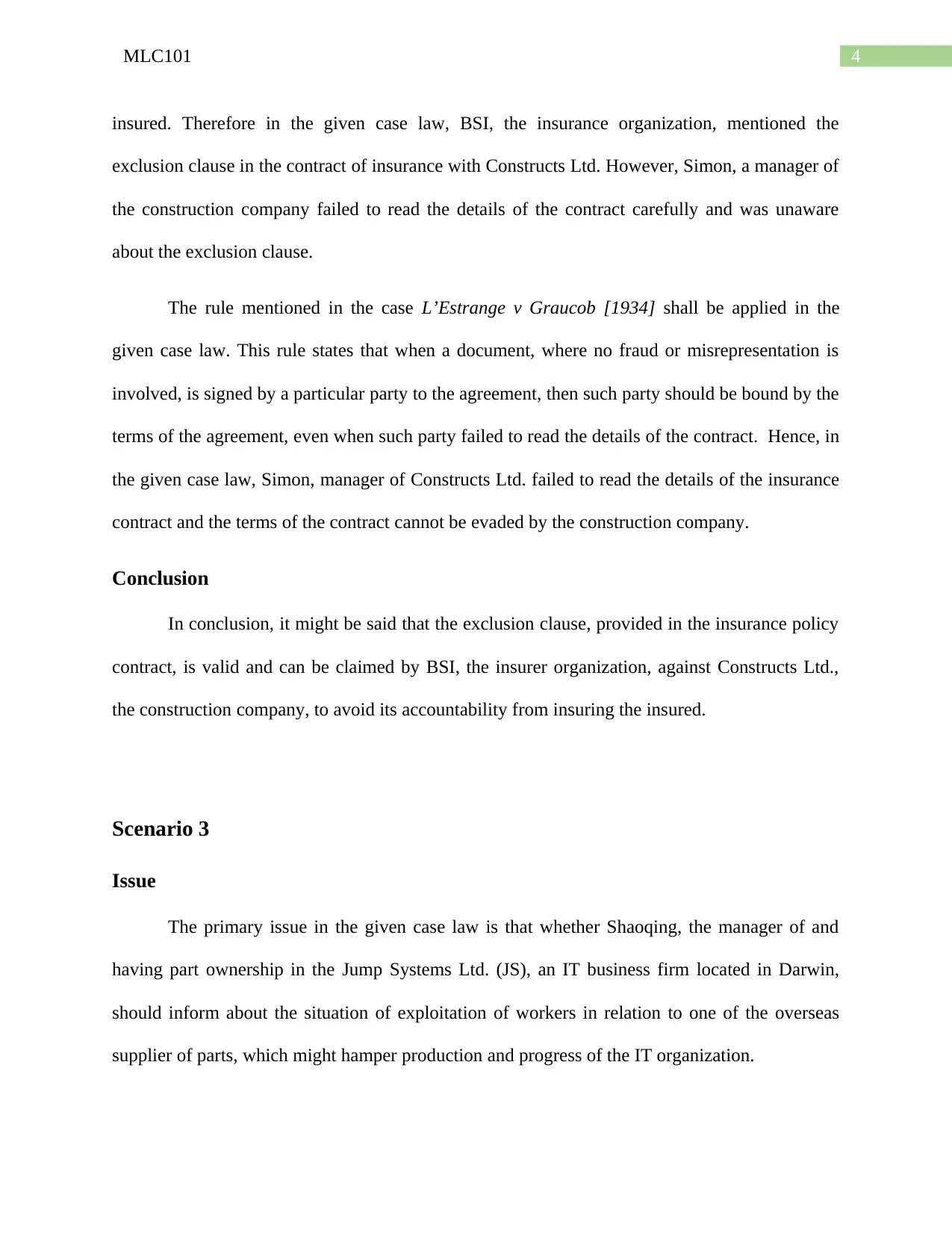
4MLC101
insured. Therefore in the given case law, BSI, the insurance organization, mentioned the
exclusion clause in the contract of insurance with Constructs Ltd. However, Simon, a manager of
the construction company failed to read the details of the contract carefully and was unaware
about the exclusion clause.
The rule mentioned in the case L’Estrange v Graucob [1934] shall be applied in the
given case law. This rule states that when a document, where no fraud or misrepresentation is
involved, is signed by a particular party to the agreement, then such party should be bound by the
terms of the agreement, even when such party failed to read the details of the contract. Hence, in
the given case law, Simon, manager of Constructs Ltd. failed to read the details of the insurance
contract and the terms of the contract cannot be evaded by the construction company.
Conclusion
In conclusion, it might be said that the exclusion clause, provided in the insurance policy
contract, is valid and can be claimed by BSI, the insurer organization, against Constructs Ltd.,
the construction company, to avoid its accountability from insuring the insured.
Scenario 3
Issue
The primary issue in the given case law is that whether Shaoqing, the manager of and
having part ownership in the Jump Systems Ltd. (JS), an IT business firm located in Darwin,
should inform about the situation of exploitation of workers in relation to one of the overseas
supplier of parts, which might hamper production and progress of the IT organization.
insured. Therefore in the given case law, BSI, the insurance organization, mentioned the
exclusion clause in the contract of insurance with Constructs Ltd. However, Simon, a manager of
the construction company failed to read the details of the contract carefully and was unaware
about the exclusion clause.
The rule mentioned in the case L’Estrange v Graucob [1934] shall be applied in the
given case law. This rule states that when a document, where no fraud or misrepresentation is
involved, is signed by a particular party to the agreement, then such party should be bound by the
terms of the agreement, even when such party failed to read the details of the contract. Hence, in
the given case law, Simon, manager of Constructs Ltd. failed to read the details of the insurance
contract and the terms of the contract cannot be evaded by the construction company.
Conclusion
In conclusion, it might be said that the exclusion clause, provided in the insurance policy
contract, is valid and can be claimed by BSI, the insurer organization, against Constructs Ltd.,
the construction company, to avoid its accountability from insuring the insured.
Scenario 3
Issue
The primary issue in the given case law is that whether Shaoqing, the manager of and
having part ownership in the Jump Systems Ltd. (JS), an IT business firm located in Darwin,
should inform about the situation of exploitation of workers in relation to one of the overseas
supplier of parts, which might hamper production and progress of the IT organization.
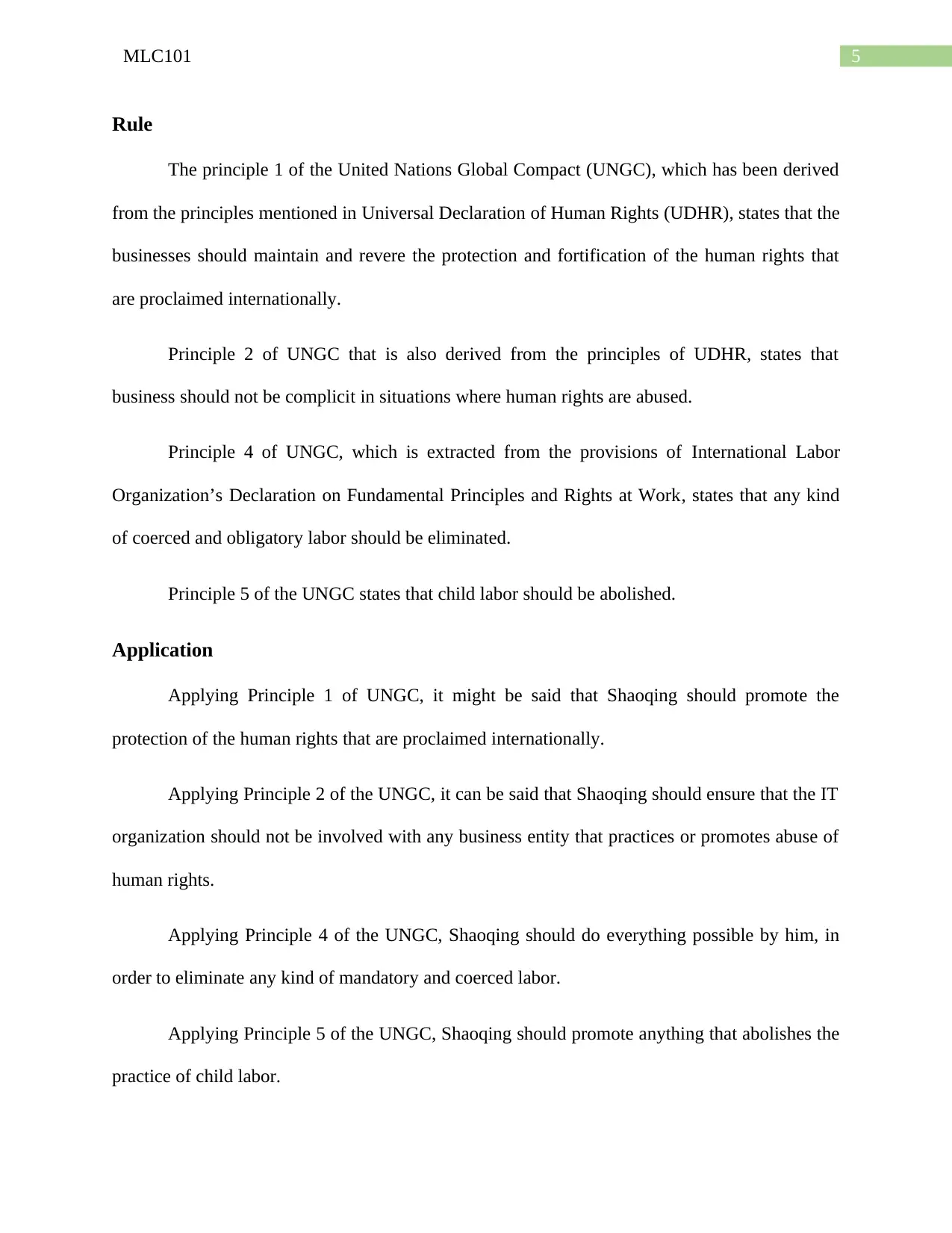
5MLC101
Rule
The principle 1 of the United Nations Global Compact (UNGC), which has been derived
from the principles mentioned in Universal Declaration of Human Rights (UDHR), states that the
businesses should maintain and revere the protection and fortification of the human rights that
are proclaimed internationally.
Principle 2 of UNGC that is also derived from the principles of UDHR, states that
business should not be complicit in situations where human rights are abused.
Principle 4 of UNGC, which is extracted from the provisions of International Labor
Organization’s Declaration on Fundamental Principles and Rights at Work, states that any kind
of coerced and obligatory labor should be eliminated.
Principle 5 of the UNGC states that child labor should be abolished.
Application
Applying Principle 1 of UNGC, it might be said that Shaoqing should promote the
protection of the human rights that are proclaimed internationally.
Applying Principle 2 of the UNGC, it can be said that Shaoqing should ensure that the IT
organization should not be involved with any business entity that practices or promotes abuse of
human rights.
Applying Principle 4 of the UNGC, Shaoqing should do everything possible by him, in
order to eliminate any kind of mandatory and coerced labor.
Applying Principle 5 of the UNGC, Shaoqing should promote anything that abolishes the
practice of child labor.
Rule
The principle 1 of the United Nations Global Compact (UNGC), which has been derived
from the principles mentioned in Universal Declaration of Human Rights (UDHR), states that the
businesses should maintain and revere the protection and fortification of the human rights that
are proclaimed internationally.
Principle 2 of UNGC that is also derived from the principles of UDHR, states that
business should not be complicit in situations where human rights are abused.
Principle 4 of UNGC, which is extracted from the provisions of International Labor
Organization’s Declaration on Fundamental Principles and Rights at Work, states that any kind
of coerced and obligatory labor should be eliminated.
Principle 5 of the UNGC states that child labor should be abolished.
Application
Applying Principle 1 of UNGC, it might be said that Shaoqing should promote the
protection of the human rights that are proclaimed internationally.
Applying Principle 2 of the UNGC, it can be said that Shaoqing should ensure that the IT
organization should not be involved with any business entity that practices or promotes abuse of
human rights.
Applying Principle 4 of the UNGC, Shaoqing should do everything possible by him, in
order to eliminate any kind of mandatory and coerced labor.
Applying Principle 5 of the UNGC, Shaoqing should promote anything that abolishes the
practice of child labor.
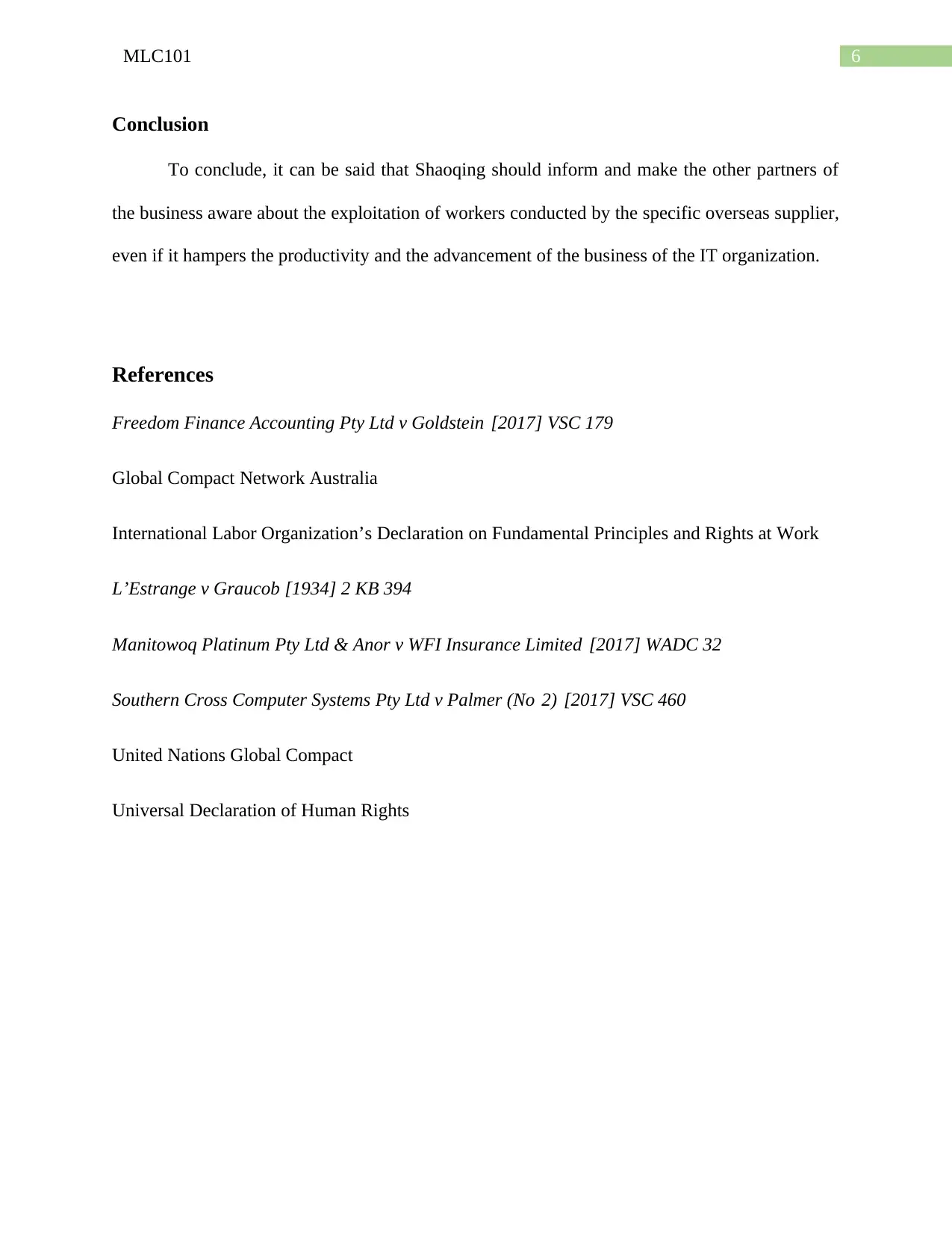
6MLC101
Conclusion
To conclude, it can be said that Shaoqing should inform and make the other partners of
the business aware about the exploitation of workers conducted by the specific overseas supplier,
even if it hampers the productivity and the advancement of the business of the IT organization.
References
Freedom Finance Accounting Pty Ltd v Goldstein [2017] VSC 179
Global Compact Network Australia
International Labor Organization’s Declaration on Fundamental Principles and Rights at Work
L’Estrange v Graucob [1934] 2 KB 394
Manitowoq Platinum Pty Ltd & Anor v WFI Insurance Limited [2017] WADC 32
Southern Cross Computer Systems Pty Ltd v Palmer (No 2) [2017] VSC 460
United Nations Global Compact
Universal Declaration of Human Rights
Conclusion
To conclude, it can be said that Shaoqing should inform and make the other partners of
the business aware about the exploitation of workers conducted by the specific overseas supplier,
even if it hampers the productivity and the advancement of the business of the IT organization.
References
Freedom Finance Accounting Pty Ltd v Goldstein [2017] VSC 179
Global Compact Network Australia
International Labor Organization’s Declaration on Fundamental Principles and Rights at Work
L’Estrange v Graucob [1934] 2 KB 394
Manitowoq Platinum Pty Ltd & Anor v WFI Insurance Limited [2017] WADC 32
Southern Cross Computer Systems Pty Ltd v Palmer (No 2) [2017] VSC 460
United Nations Global Compact
Universal Declaration of Human Rights
1 out of 7
Related Documents
Your All-in-One AI-Powered Toolkit for Academic Success.
+13062052269
info@desklib.com
Available 24*7 on WhatsApp / Email
![[object Object]](/_next/static/media/star-bottom.7253800d.svg)
Unlock your academic potential
© 2024 | Zucol Services PVT LTD | All rights reserved.





